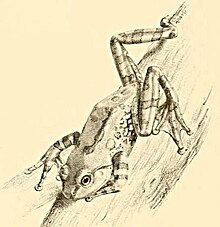Ghatixalus
| Ghatixalus | |
|---|---|

| |
| Ghatixalus variabilis | |
| Scientific classification | |
| Domain: | Eukaryota |
| Kingdom: | Animalia |
| Phylum: | Chordata |
| Class: | Amphibia |
| Order: | Anura |
| Family: | Rhacophoridae |
| Subfamily: | Rhacophorinae |
| Genus: | Ghatixalus Biju, Roelants, and Bossuyt, 2008[1] |
| Type species | |
| Polypedates variabilis Jerdon, 1854
| |
| Species | |
|
3, see text | |
Ghatixalus is a group of frogs in the family Rhacophoridae, subfamily Rhacophorinae. They live in the Western Ghat mountains, which are in southern India. They are the closely related to the frogs in Chiromantis, Feihyla, Taruga, Polypedates, and Rhacophorus.[2][3] Scientists used the words "Ghats" and "Ixalus" to make the name. "Ghats" is for the Western Ghat mountains and "Ixalus" is for the old name of another group of frogs. Many groups of frogs in Rhacophoridae have ixalus in their names for this reason.[1]
Description
[change | change source]Ghatixalus are medium to very large in size. Adult male frogs can be 39–82 mm (1.5–3.2 in) from nose to rear end and adult female frogs 58–67 mm (2.3–2.6 in). The skin of the frog's back is brown with darker brown marks. Eggs develop in foam nests and hatch into tadpoles. These frogs live in mountain streams for their whole lives.[1][3]
Distribution and natural history
[change | change source]This frog only lives in Shola forests, so it only lives high up in the Nilgiris and Anaimalai-Palnis, more than 1600 meters above sea level. When people see these frogs, they are usually near streams, sitting on the ground or on grass. Although most frogs in Rhacophoridae are tree frogs, the frogs in Ghatixalus live on the ground.
Species
[change | change source]There are only three species in the genus Ghatixalus:[2]
- Ghatixalus asterops Biju, Roelants, and Bossuyt, 2008 endemic to Upper Palni Hills, Anaimalai and High Ranges.
- Ghatixalus magnus Abraham, Mathew, Cyriac, Zachariah, Raju and Zachariah, 2015 endemic to the Anaimalai Hills, High Ranges, Cardamom Hills, Meghamalai and Pandalam Hills
- Ghatixalus variabilis (Jerdon, 1854) endemic to Upper Nilgiri Hills
The Palakkad Gap is between the place where G. asterops live and where G. variabilis frogs live. This may be why they became two species.
References
[change | change source]- ↑ 1.0 1.1 1.2 Biju, S.; Roelants, K.; Bossuyt, F. (2008). "Phylogenetic position of the montane treefrog Polypedates variabilis Jerdon, 1853 (Anura: Rhacophoridae), and description of a related species". Organisms Diversity & Evolution. 8 (4): 267–276. doi:10.1016/j.ode.2007.11.004.
- ↑ 2.0 2.1 Frost, Darrel R. (2013). "Ghatixalus Biju, Roelants, and Bossuyt, 2008". Amphibian Species of the World 5.6, an Online Reference. American Museum of Natural History. Retrieved 16 November 2013.
- ↑ 3.0 3.1 Li, Jiatang; Dingqi Rao; Robert W. Murphy; Yaping Zhang (2011). "The systematic status of rhacophorid frogs" (PDF). Asian Herpetological Research. 2: 1–11. doi:10.3724/SP.J.1245.2011.00001. Archived from the original (PDF) on 3 December 2013. Retrieved 16 November 2013.
Other websites
[change | change source]
